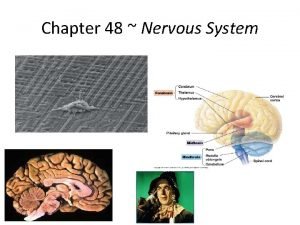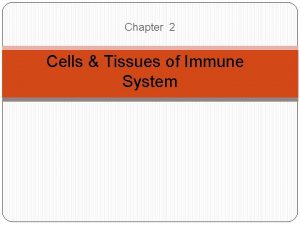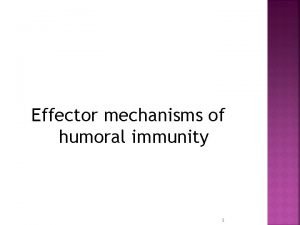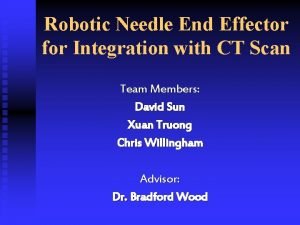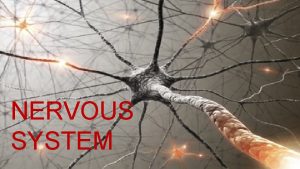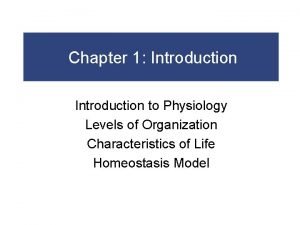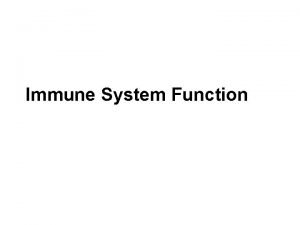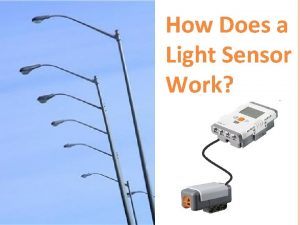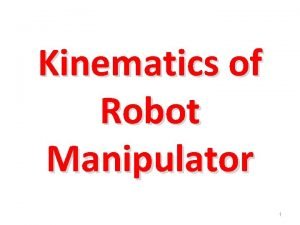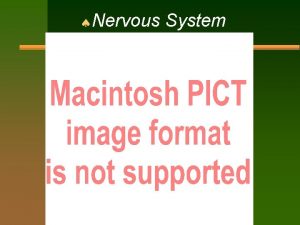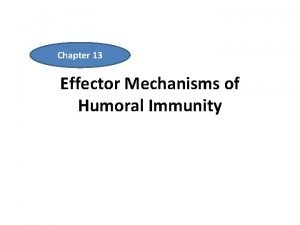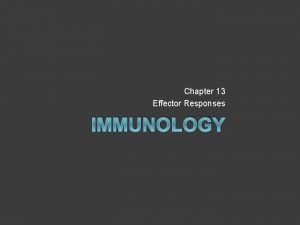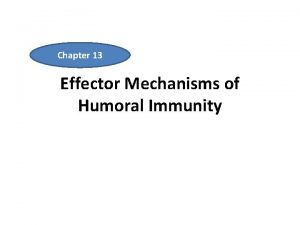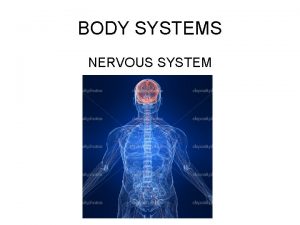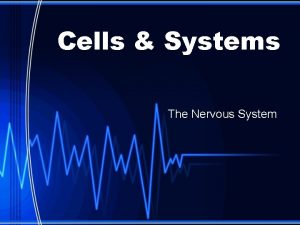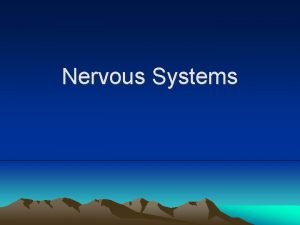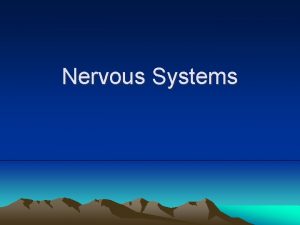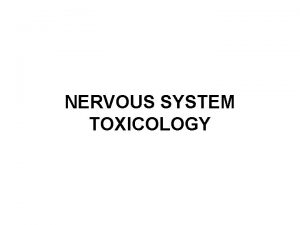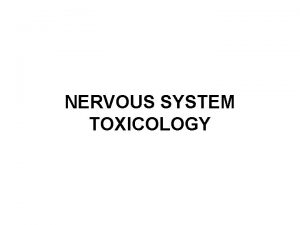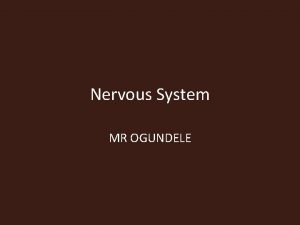Chapter 48 Nervous System Nervous systems Effector cells






























- Slides: 30

Chapter 48 ~ Nervous System

Nervous systems • Effector cells~ muscle or gland cells • Nerves~ bundles of neurons wrapped in connective tissue • Central nervous system (CNS)~ brain and spinal cord • Peripheral nervous system (PNS)~ sensory and motor neurons

Nervous system cells § Neuron signal direction u a nerve cell dendrites cell body § Structure fits function many entry points for signal u one path out u transmits signal u axon signal direction myelin sheath dendrite cell body axon synaptic terminal synapse

Fun facts about neurons • Most specialized cell in animals • Longest cell – blue whale neuron • 10 -30 meters – giraffe axon • 5 meters – human neuron • 1 -2 meters Nervous system allows for 1 millisecond response time

Simple Nerve Circuit • • • Sensory neuron: convey information to spinal cord Interneurons: information integration Motor neurons: convey signals to effector cell (muscle or gland) Reflex: simple response; sensory to motor neurons Ganglion (ganglia): cluster of nerve cell bodies in the PNS Supporting cells/glia: nonconductiong cell that provides support, insulation, and protection

Transmission of a signal • Think dominoes! – start the signal • knock down line of dominoes by tipping 1 st one trigger the signal – propagate the signal • do dominoes move down the line? no, just a wave through them! – re-set the system • before you can do it again, have to set up dominoes again reset the axon

Transmission of a nerve signal • Neuron has similar system – protein channels are set up – once first one is opened, the rest open in succession • all or nothing response – a “wave” action travels along neuron – have to re-set channels so neuron can react again

Cells: surrounded by charged ions • Cells live in a sea of charged ions – anions (negative) • more concentrated within the cell • Cl-, charged amino acids (aa-) – cations (positive) • more concentrated in the extracellular fluid • Na+ Na K+ aa- K+ Na+ aa. Cl- Na+ Cl. K+ Na+ aa- Na+ K+ aa- K+ Na+ Cl. Cl- Na+ aa- Na+ Na+ Claa- Cl- – K+ + channel leaks K+ +

Cells have voltage! • Opposite charges on opposite sides of cell membrane – membrane is polarized • negative inside; positive outside • charge gradient • stored energy (like a battery) + + + + – – – – – – – + + + +

Measuring cell voltage unstimulated neuron = resting potential of -70 m. V

How does a nerve impulse travel? • Stimulus: nerve is stimulated – reaches threshold potential • open Na+ channels in cell membrane • Na+ ions diffuse into cell – charges reverse at that point on neuron The 1 st domino goes down! • positive inside; negative outside • cell becomes depolarized – + + + + – – – – Na+ + – – – – + + + +

How does a nerve impulse travel? • Wave: nerve impulse travels down neuron – change in charge opens + – + next Na gates down the line • “voltage-gated” channels channel – Na+ ions continue to diffuse into cell closed – “wave” moves down neuron = action potential Gate The rest of the dominoes fall! + + channel open – – – + + + + – – – Na+ + – – – – + + + wave

How does a nerve impulse travel? • Re-set: 2 nd wave travels down neuron – K+ channels open • K+ channels open up more slowly than Na+ channels – K+ ions diffuse out of cell – charges reverse back at that point • negative inside; positive outside Set dominoes back up quickly! K+ + – – + + + + + – – – – – Na+ – + + – – – – – + + + + + wave

How does a nerve impulse travel? • Combined waves travel down neuron – wave of opening ion channels moves down neuron – signal moves in one direction • flow of K+ out of cell stops activation of Na+ channels in wrong direction Ready for next time! K+ + – – + + + + – – – – Na+ – – – + + – – – – + + + + wave

How does a nerve impulse travel? • Action potential propagates – wave = nerve impulse, or action potential – brain finger tips in milliseconds! In the blink of an eye! K+ + + + – – – – Na+ – – – – + + + + wave

Voltage-gated channels • Ion channels open & close in response to changes in charge across membrane – Na+ channels open quickly in response to depolarization & close slowly – K+ channels open slowly in response to depolarization & close slowly Structure & function! K+ + + + + – – – – – + + + – – – Na+ – – – – – + + + + + – – – + + + wave

How does the nerve re-set itself? • After firing a neuron has to re-set itself – Na+ needs to move back out – K+ needs to move back in – both are moving against concentration gradients • need a pump!! A lot of work to do here! K+ + Na Na+ + K K Na+ Na+ K+ K+ Na+ + Na Na + + + + + – – +– – – – + + – Na+ Na K+ K+ K++ Na Na+ K+ + + Na K K K Na+ K+ – – – – – + + + + + – – + wave Na+ +

How does the nerve re-set itself? • Sodium-Potassium pump – active transport protein in membrane • requires ATP – 3 Na+ pumped out – 2 K+ pumped in – re-sets charge across membrane That’s a lot of ATP ! Feed me some sugar quick! ATP

Neuron is ready to fire again Na+ Na+ K+ aa- aa. Na+ Na+ K+ Na+ aa- K+ Na+ Na+ K+ aa. Na+ Na+ Na+ K+ aa- K+ K+ Na+ Na+ resting potential + + + + – – – – – – – – + + + +

Action potential graph 40 m. V 4 30 m. V 20 m. V Membrane potential 1. Resting potential 2. Stimulus reaches threshold potential 3. Depolarization Na+ channels open; K+ channels closed 4. Na+ channels close; K+ channels open 5. Repolarization reset charge gradient 6. Undershoot K+ channels close slowly 10 m. V Depolarization Na+ flows in 0 m. V – 10 m. V 3 – 20 m. V Repolarization K+ flows out 5 – 30 m. V – 40 m. V – 50 m. V Threshold – 60 m. V – 70 m. V – 80 m. V Hyperpolarization (undershoot) 2 1 Resting potential 6 Resting

Myelin sheath § Axon coated with Schwann cells signal direction insulates axon u speeds signal u § signal hops from node to node § saltatory conduction u 150 m/sec vs. 5 m/sec (330 mph vs. 11 mph) myelin sheath

action potential saltatory conduction Na+ myelin axon + + + – – Na+ Multiple Sclerosis § immune system (T cells) attack myelin sheath § loss of signal

What happens at the end of the axon? Impulse has to jump the synapse! – junction between neurons – has to jump quickly from one cell to next How does the wave jump the gap? Synapse

Chemical synapse axon terminal § Events at synapse action potential u synaptic vesicles synapse u u Ca++ receptor protein u neurotransmitter acetylcholine (ACh) u muscle cell (fiber) We switched… from an electrical signal u to a chemical signal action potential depolarizes membrane opens Ca++ channels neurotransmitter vesicles fuse with membrane release neurotransmitter to synapse diffusion neurotransmitter binds with protein receptor § ion-gated channels open neurotransmitter degraded or reabsorbed

Nerve impulse in next neuron K+ • Post-synaptic neuron – triggers nerve impulse in next nerve cell • chemical signal opens ion-gated channels Na+ + binding site • Na diffuses into cell • K+ diffuses out of cell Here we go again! – switch back to voltage-gated channel ion channel K+ ACh K+ – + + + + – – – – Na+ + – – – – + + + + Na+

Neurotransmitters • Acetylcholine – transmit signal to skeletal muscle • Epinephrine (adrenaline) & norepinephrine – fight-or-flight response • Dopamine – widespread in brain – affects sleep, mood, attention & learning – lack of dopamine in brain associated with Parkinson’s disease – excessive dopamine linked to schizophrenia • Serotonin – widespread in brain – affects sleep, mood, attention & learning

Neurotransmitters • Weak point of nervous system – any substance that affects neurotransmitters or mimics them affects nerve function • gases: nitrous oxide, carbon monoxide • mood altering drugs: – stimulants » amphetamines, caffeine, nicotine – depressants » quaaludes, barbiturates • hallucinogenic drugs: LSD, peyote • SSRIs: Prozac, Zoloft, Paxil • poisons

Acetylcholinesterase • Enzyme which breaks down acetylcholine neurotransmitter – acetylcholinesterase inhibitors = neurotoxins • snake venom, sarin, insecticides neurotoxin in green active site in red acetylcholinesterase snake toxin blocking acetylcholinesterase active site

Vertebrate PNS • • Cranial nerves (brain origin) Spinal nerves (spine origin) Sensory division Motor division • somatic system voluntary, conscious control • autonomic system √parasympathetic conservation of energy √sympathetic increase energy consumption

The Vertebrate Brain • Forebrain • cerebrum~memory, learning, emotion • cerebral cortex~sensory and motor nerve cell bodies • corpus callosum~connects left and right hemispheres • thalamus; hypothalamus • Midbrain • inferior (auditory) and superior (visual) colliculi • Hindbrain • cerebellum~coordination of movement • medulla oblongata/ pons~autonomic, homeostatic functions
 Effector cells in nervous system
Effector cells in nervous system Immune effector cells
Immune effector cells Immune effector cells
Immune effector cells Identify each type of neuronal pool
Identify each type of neuronal pool Nervous
Nervous Neuronal processes
Neuronal processes Nondisjunction in meiosis
Nondisjunction in meiosis Effector mechanism of humoral immunity
Effector mechanism of humoral immunity End effector needle
End effector needle Integration center
Integration center Sensor integrator effector
Sensor integrator effector Function of antibody
Function of antibody How a light sensor works
How a light sensor works Homogeneous transformation matrix
Homogeneous transformation matrix Chapter 14 skeletal muscular and nervous systems
Chapter 14 skeletal muscular and nervous systems Onodi cells and haller cells
Onodi cells and haller cells Alpha intercalated cells
Alpha intercalated cells Parafollicular cells vs follicular cells
Parafollicular cells vs follicular cells Gamete vs somatic cell
Gamete vs somatic cell Why dna is more stable than rna
Why dna is more stable than rna Chlorocruorin
Chlorocruorin Prokaryote vs eukaryote
Prokaryote vs eukaryote Plant and animal cell venn diagram
Plant and animal cell venn diagram Prokaryotic cell
Prokaryotic cell Why did robert hooke name cells “cells”?
Why did robert hooke name cells “cells”? Masses of cells form and steal nutrients from healthy cells
Masses of cells form and steal nutrients from healthy cells Label
Label Cuál es la diferencia entre la célula animal y vegetal
Cuál es la diferencia entre la célula animal y vegetal Is a staphylococcus cell prokaryotic or eukaryotic
Is a staphylococcus cell prokaryotic or eukaryotic Cell substance
Cell substance Nervous system and digestive system
Nervous system and digestive system
